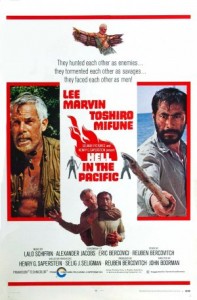They hunted each other as enemies…they tormented each other as savages…they faced each other as men!
Having a picture which only has two on screen cast members has been done many times, though perhaps never as well as in director John Boorman’s 1968 Hell in the Pacific. Here the actors are [intlink id=”1280″ type=”category”]Lee Marvin[/intlink] and perennial Kurosawa favorite Toshiro Mifune.
Here the stars are marooned servicemen on a small and otherwise nondescript atoll in the Pacific during World War II. Initially there is a potentially deadly game of hide and seek among the two with Toshiro, being the “original” inhabitant of the island, discovering the presence of a downed American airman, Lee Marvin.
The plot is typical given the setting but there are more than enough quirks to make this one worth your while. Of course after the two tire each other out trying to kill or at least annoy one another they opt to work together. But even then it isn’t the Disneyesque cooperation one may expect. Rather, they are like two bickering old women, each screaming at the other and pointing wildly when they don’t get their way.
After awhile Marvin, who- at least if you believe him- has been doing all the cooking for the duo, blows his top and quits, going over to sulk by the surf while Toshiro continues to busy himself catching food and the like. The limited ability of the duo to communicate adds to the tension.
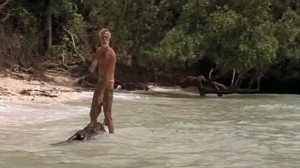 There is a particular and presumably intentionally humorous scene where Toshiro absconds with one of Lee Marvin’s driftwood logs and uses it to attempt to make a ramshackle raft. Enraged, Marvin rips the log from the would be raft and drags it back to his portion of the beach, screaming “My log!” repeatedly while randomly pointing at either the log or himself (depending on where he is in the rant).
There is a particular and presumably intentionally humorous scene where Toshiro absconds with one of Lee Marvin’s driftwood logs and uses it to attempt to make a ramshackle raft. Enraged, Marvin rips the log from the would be raft and drags it back to his portion of the beach, screaming “My log!” repeatedly while randomly pointing at either the log or himself (depending on where he is in the rant).
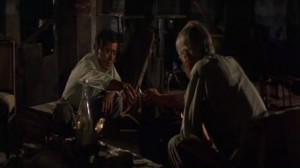 Eventually, they decide to work together to build this raft and do escape to another slightly larger island. This one has a Japanese military base on it but has been abandoned after Americans shelled and overran it. As they explore separately Toshiro trips slightly over a piece of wreckage, startling Marvin. In response, Marvin quips, “Watch out- I almost thought you were a Jap!” It’s a very telling comment as it speaks to the fact that no longer do the two men view each other as faceless inhuman enemies, but rather as defined human colleagues.
Eventually, they decide to work together to build this raft and do escape to another slightly larger island. This one has a Japanese military base on it but has been abandoned after Americans shelled and overran it. As they explore separately Toshiro trips slightly over a piece of wreckage, startling Marvin. In response, Marvin quips, “Watch out- I almost thought you were a Jap!” It’s a very telling comment as it speaks to the fact that no longer do the two men view each other as faceless inhuman enemies, but rather as defined human colleagues.
There are two endings to the film, of which I have only seen the original, and perhaps more abrupt ending, which I will not share the details of here, in case you should want to check Hell in the Pacific out. It is shocking to say the least.
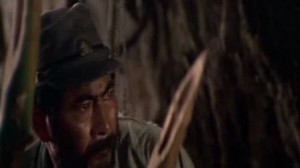 What I haven’t shared yet is what the most innovative aspect of the picture is. Both Marvin and Mifune speak in their native tongues, and without the benefit of subtitles. So if you are (or were) in the States, and presumably don’t understand Japanese, you haven’t the foggiest idea what Toshiro is talking about. And vice versa for those in Japan, who won’t understand Marvin’s rantings.
What I haven’t shared yet is what the most innovative aspect of the picture is. Both Marvin and Mifune speak in their native tongues, and without the benefit of subtitles. So if you are (or were) in the States, and presumably don’t understand Japanese, you haven’t the foggiest idea what Toshiro is talking about. And vice versa for those in Japan, who won’t understand Marvin’s rantings.
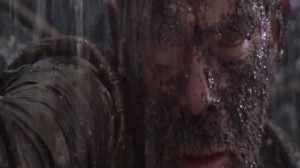 While some may be disenchanted by this, the truth of the matter is that it really doesn’t matter one iota what they are saying. The actions and emotions around them speak for themselves.
While some may be disenchanted by this, the truth of the matter is that it really doesn’t matter one iota what they are saying. The actions and emotions around them speak for themselves.
Is it a classic? Probably not, but it is well worth a watch. Bleak, but sometimes humorous, Hell in the Pacific is a good if not great picture. Lalo Shifrin’s score is dissonant but probably a good fit for the picture, though not to my particular liking.
Highly recommended if you are looking for an objective and unprejudiced telling of a riveting story.
